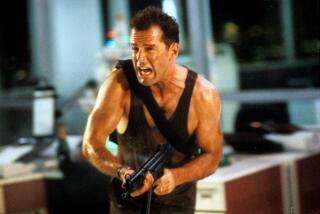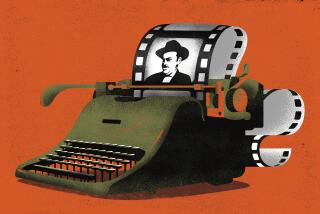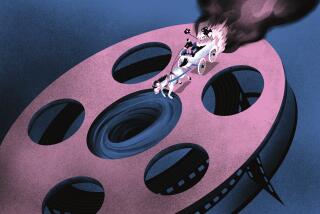Orson Welles Gets Final Cut--at Last
In a strange twist of fate, Orson Welles will be vindicated by the same studio that spurned him 40 years ago.
After altering his flamboyantly offbeat vision for “Touch of Evil,” the cultish noir thriller whose failure doomed any hope for him of a Hollywood comeback, Universal has green-lighted the reconstruction of Welles’ intended version--concluding one of the most mysterious projects of his tempestuous career.
Filmmaker Rick Schmidlin, who has passionately pursued the project for four years, will produce the “Touch of Evil” reconstruction with acclaimed editor Walter Murch (last year’s Oscar winner for “The English Patient”). They will collaborate with Universal preservation director Bob O’Neil and sound operations vice president Bill Varney (an Oscar winner for both “The Empire Strikes Back” and “Raiders of the Lost Ark”). Jonathan Rosenbaum, the dedicated Welles scholar, will assist as research consultant.
“This is not a restoration or a new Welles film,” Schmidlin says. “We want to tell his story with the punctuation points he wanted. This will be a clear example of what Welles intended ‘Touch of Evil’ to be and how to present it.”
With “Touch of Evil,” his first American film after a decade in exile, Welles transformed pulp fiction about police corruption into a baroque Shakespearean tragedy about love, loss and betrayal. At the same time, it was a Grand Guignol black comedy (shot in nearby Venice) with a bizarre cast: Charlton Heston as a Mexican cop! Marlene Dietrich as a fortuneteller! Akim Tamiroff as a bumbling gangster! And Welles as a gargoyle-like detective more “frightened than frightening”!
But it was his film’s jarring and audacious editing style that got Welles into the most trouble with Universal, which released a more conventional B-movie--inserting new footage and rearranging the director’s cross-cutting design for geographic clarity, as well as sweetening the love story between Heston and co-star Janet Leigh as his wife.
Although there are currently three versions of the film in circulation--a 108-minute preview print, a 93-minute release print and an amalgamation on home video--Welles’ unfinished rough cut no longer exists. What does exist, however, is a detailed 58-page memo the director wrote in 1957 to then-studio chief Edward Muhl after he was barred from the editing room. (Until his rough cut was screened by Universal, Welles maintained that he received the studio’s full cooperation.)
The memo, excerpted by Rosenbaum in a 1992 Film Quarterly article, was in response to Welles’ viewing of the studio’s rough cut (which included about 10 minutes of new footage shot by director Harry Keller). Welles implored Muhl to implement his suggestions to improve the film. A few of the suggestions were incorporated into the longer preview version in early 1958, but the rest were ignored--until now.
“The big question is, ‘What did Welles intend?’ ” Schmidlin says. “I finally put the pieces together after uncovering a gold mine of background material. I even discovered some lost documents at USC. We have all of Welles’ editorial notes and the shooting script, but the best thing we have is the complete memo. We will be using the memo as our guide in piecing together what Welles intended. We want to figure out where this man’s mind was at in 1957.”
According to the memo, Welles argued for the restoration of his cross-cutting on the basis of dramatic contrast and stylistic consistency. He additionally called for an improved sound mix and the retention of only those scenes shot by Keller that he approved.
“By rearranging the action in a different order, it gives new meaning,” Schmidlin adds. “A Dietrich reaction shot at the end was put in the wrong place. Put it in the right place, and the emotion changes. We also know that Welles was very influenced by Italian neo-realism at the time--and that ‘Shoeshine’ was his favorite. I think we’ll realize that Welles was making a Hollywood neo-realist B-movie.”
Rosenbaum counters that “Touch of Evil” was really a return to one of Welles’ own influences: “This will not transform the film,” he says. “We won’t know until we see it, what the impact will be, but Welles worked on certain concepts for sequences, using sound to create a sense of space, that comes back to his roots in radio. For example, the end is full of disembodied voices coming from loudspeakers indicative of the radio influence.”
The most noticeable change will occur in the famous opening sequence, with the removal of the main titles, drawing us more deeply into the myriad sights and sounds along the seedy Mexican border in that bravura tracking shot leading up to the exploding car.
The plan is to reconstruct a new version from the surviving negative and the preview print that was immediately shelved (and rediscovered in the mid-1970s by the UCLA Film and Television Archive).
“We can make a new duplicate negative from this blend, and we have the original magnetic sound masters to work with for the first time,” O’Neil explains. “This means that we can separate dialogue, music and effects, clean them up and hear them better. My job will be to provide a seamless look by matching contrast and densities. This will be made a lot easier with the help of digital technology.”
Murch, celebrated for his groundbreaking work on both “The Conversation” and “Apocalypse Now,” was recruited by Schmidlin primarily because of his sound expertise, and because he is a fan of “Touch of Evil.”
“This is a process of discovery for me,” Murch says. “In reading the memo, you learn how articulate Welles was on sound and how much space he devoted to it. For the time, he was really in advance [of what people were doing]. We have a few specific guidelines, but fate has left it up to us to decide where we do our transitions. There will be a little bit of channeling Mr. Welles.
“Certain directions that he went in some scenes will be present in other scenes. There’s a succession of different Latin musical numbers--loud, contrasting mambo and rock--that he wanted highlighted in the opening and in other scenes. It’s wonderfully similar to what George Lucas and I did 14 years later in ‘American Graffiti’ with Wolfman Jack. Welles got the jump.”
Meanwhile, the integral cross-cutting that Welles emphasized begins after the explosion, when Heston starts his investigation and separates from Leigh, who becomes the target of sadistic abuse by Tamiroff’s gang.
Welles writes: “What’s vital is that both stories--the leading man’s and the leading woman’s--be kept equally and continuously alive; each scene, as we move back and forth across the border, should play at roughly equal lengths leading up to the moment at the hotel when the lovers meet again. . . . No point concerning anything in the picture is made with such urgency and such confidence as this. Do please-please give it a fair try.”
“It really plays better--every time we make a change,” Schmidlin offers. “He was working on a rhythmic opening that was not accepted by the studio, and we can’t understand why. If Welles had had an editor like Walter, who understands this rhythm, he might’ve convinced them, but we’re lucky to have him now.”
Director Peter Bogdanovich, who became Welles’ confidant as a journalist in the late 1960s, isn’t surprised: “It proves how you can damage a movie and not realize it when it’s cut differently. Orson was not conventional in any way. He was way ahead of us and we’re still catching up.” (A new edition of “This Is Orson Welles,” an account of their conversations, edited by Rosenbaum, will be published by De Cappa in February, containing the excerpted version of the memo.)
Heston, who asserts that he was the first to suggest that Welles direct “Touch of Evil,” actually saw the director’s work print, and downplays the differences: “The original cut was very close to what Universal wanted,” the actor says. “They did nothing to alter his original conception of the film. I think he liked to be painted into a corner. . . . I think he got bored when he turned in the film. He walked away and went to Mexico [to start “Don Quixote”]. You just don’t do that. It was a sufficient enough film to rejuvenate his career.
“Orson was absolutely brilliant in preparing and shooting a film . . . working with actors and crews. It was the closest I’ve ever come to making it fun. My main contribution to film may be that I made it possible for Orson to make his last American film.”
A spring completion is anticipated for the reconstructed “Touch of Evil,” with the film opening in several big markets in the fall, including the Nuart in West Los Angeles. October Films will be distributing the film.
“It’ll be great to reexamine it in light of today,” Murch adds. “It will allow people to see how ‘L.A. Confidential’ is ‘Touch of Evil’ circa 1958 because of the corruption--a second- or third-generation influence. But it’s really about Welles himself. It’s so poignant . . . so self-referential . . . so prophetic, when he sees his old lover, Dietrich, and she tells him he has no future. We’re just trying to do the best job we can and lay some ghosts to rest and make Orson happier.”
More to Read
The biggest entertainment stories
Get our big stories about Hollywood, film, television, music, arts, culture and more right in your inbox as soon as they publish.
You may occasionally receive promotional content from the Los Angeles Times.










